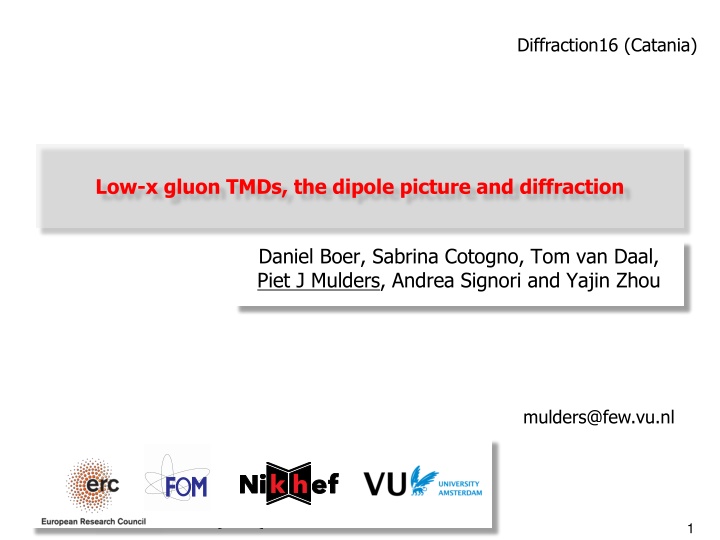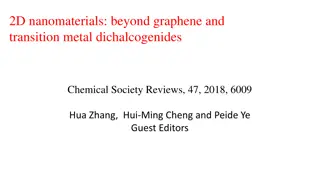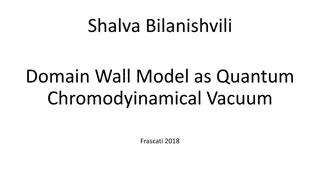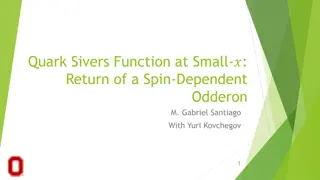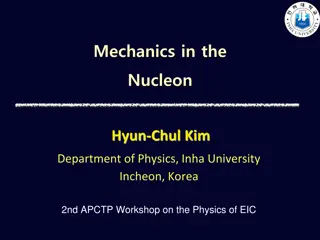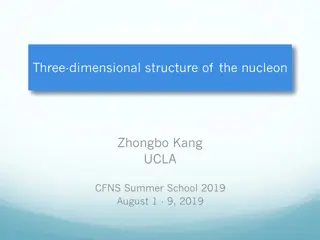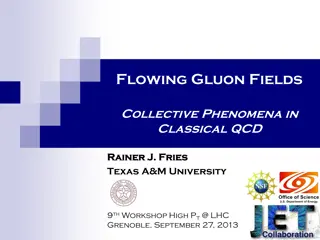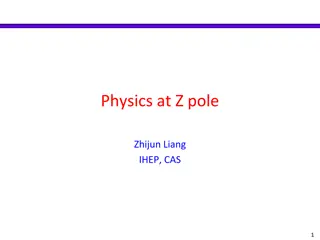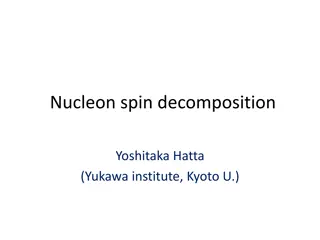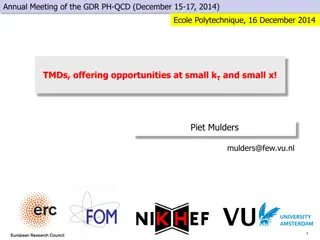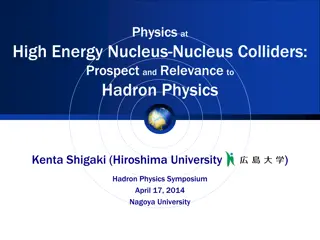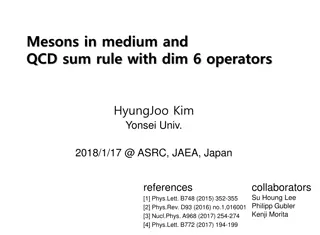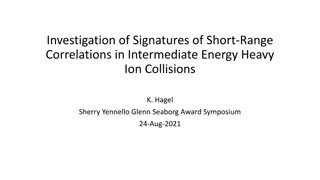Unifying Small-x Descriptions of Gluon TMDs
We delve into the momentum distributions of gluons and examine the dependence of gluon parton distribution functions (PDFs) on fractional momentum and transverse momentum, known as gluon Transverse Momentum Distributions (TMDs). Exploring the operator structure of TMDs, we bring together various descriptions at small-x, such as the dipole picture and notions of Pomeron and Odderon exchange. We analyze the structure of gluon TMDs for different target polarizations, study TMD correlators, operator structure, parametrizations, and the Wilson loop correlator, bridging ideas on diffraction, dipole picture, and small-x behavior.
Download Presentation

Please find below an Image/Link to download the presentation.
The content on the website is provided AS IS for your information and personal use only. It may not be sold, licensed, or shared on other websites without obtaining consent from the author.If you encounter any issues during the download, it is possible that the publisher has removed the file from their server.
You are allowed to download the files provided on this website for personal or commercial use, subject to the condition that they are used lawfully. All files are the property of their respective owners.
The content on the website is provided AS IS for your information and personal use only. It may not be sold, licensed, or shared on other websites without obtaining consent from the author.
E N D
Presentation Transcript
Diffraction16 (Catania) Low-x gluon TMDs, the dipole picture and diffraction Daniel Boer, Sabrina Cotogno, Tom van Daal, Piet J Mulders, Andrea Signori and Yajin Zhou mulders@few.vu.nl 1
Abstract Abstract We discuss the momentum distributions of gluons and consider the dependence of the gluon parton distribution functions (PDFs) on both fractional (longitudinal) momentum x and transverse momentum pT, referred to as the gluon TMDs. Looking at the operator structure of the TMDs, we are able to unify various descriptions at small-x including the dipole picture and the notions of pomeron and odderon exchange. We study the structure of gluon TMDs for unpolarized, vector polarized and tensor polarized targets. 1. TMD correlators and their operator structure, color gauge invariance 2. Parametrizations including polarization up to spin 1 3. Rank of TMD and operator structure 4. The Wilson loop correlator unifying ideas on diffraction, dipole picture and small-x behavior 2
Introduction k k PDFs and TMDs to incorporate hadron structure yi(x) yj(0) k k High energies (lightlike n = P /P.P and P.n=1) Gg ab(p) Polarized targets provide opportunities and challenges At high energies x linked to scaling variables (e.g. x = Q2/2P.q) and convolutions of transverse momenta are linked to azimuthal asymmetries (noncollinearity) requiring semi-inclusivity and/or polarization Operator structure PDFs and TMDs can be embedded in a field theoretical framework via Operator Product Expansion (OPE), connecting Mellin moments and transverse moments of (TMD) PDFs with particular QCD matrix elements of operators (spin and twist expansion, gluonic pole matrix elements) 3
Matrix elements for TMDs quark-quark yi(x) yj(0) gluon-gluon quark-gluon-quark Gab(p) A(p-p1,p) d4x d4h (2p)8 d4x d4h (2p)8 ei( p-p1).x+ip1.hP yj(0)Da(h)yi(x) P a(p- p1,p1| p)= FD;ij ei(p-p1).x+ip1.hP yj(0)Fna(h)yi(x) P a(p- p1,p1| p)= FF;ij 4
TMDs and color gauge invariance Gauge invariance in a non-local situation requires a gauge link U(0, ) 1 n!x n mNy(0) m1... mNy(0) m1... y(0)y(x)= x = ig ds A P (0, ) exp U 0 1 n!x n mNy(0)Dm1...DmNy(0) m1... y(0)U(0,x)y(x)= x Introduces path dependence for (x,pT) .P Dominant paths: along lightcone connected at lightcone infinity (staples) Reduces to straight line for (x) F[U](x,pT) F(x) 5
Matrix elements for TMDs quark-quark gluon-gluon and even single Wilson loop correlator 6
Non-universality because of process dependent gauge links d(x.P)d2xT (2p)3 ei p.xP yj(0)U[0,x] Fij q[C](x,pT;n)= [C]yi(x) P TMD x.n=0 path dependent gauge link Gauge links associated with dimension zero (not suppressed!) collinear An = A+ gluons, leading for TMD correlators to process-dependence: SIDIS DY A+ (resummation) A+ [-] [+] Time reversal Belitsky, Ji, Yuan, 2003; Boer, M, Pijlman, 2003 7
Color flow and gauge-link can become complex Hadron ( ) COLOR hard or Hadron (+) 10
Non-universality because of process dependent gauge links d(x.P)d2xT (2p)3 Gab[C,C'](x,pT;n)= ei p.xP U[x,0] [C]Fna(0)U[0,x] [C']Fnb(x) P x.n=0 The TMD gluon correlators contain two links, which can have different paths. Note that standard field displacement involves C = C [ ] [ , ] [ ] [ , ] C C ( ) ( ) F U F U gg H Basic (simplest) gauge links for gluon TMD correlators: g[-,-] g[+,+] g[+,-] g[-,+] in gg QQ Bomhof, M, Pijlman, 2006; Dominguez, Xiao, Yuan, 2011 11
Color flow classes for gluons (in lower hadron) Gluon correlators at small x related to Wilson loop correlator Wilson loop correlator linked to dipole picture and diffraction at small x (depends actually on k2 ~ kT2 in region where k+k = xk P+ << |kT2|) 12
A TMD picture for diffractive scattering y(x2) y(02) y(x2) y(02) q q [ ,0 ] [ , ] 1 1 X p2 k2 + + [0 , ][0 , ] + + [ , ][ , ] p1 GAP 1 2 GAP GAP 1 2 P P Y x1T x1T 01T 01T Momentum flow in case of diffraction x1 MX2/W2 0 and t p1T2 Picture in terms of TMD and inclusion of gauge links (including gauge links/collinear gluons in M ~ S 1) (Another way of looking at diffraction, cf Dominguez, Xiao, Yuan 2011 or older work of Gieseke, Qiao, Bartels 2000) 13
Quark correlator Unpolarized target Vector polarized target Surviving in collinear correlators (x) and including flavor index Note: be careful with use of h1T and non-traceless tensor with kT.ST since h1T is not a TMD of definite rank! 14
Definite rank TMDs Expansion in constant tensors in transverse momentum space or traceless symmetric tensors (of definite rank) Simple azimuthal behavior: functions showing up in cos(m ) or sin(m ) asymmetries (wrt e.g. T) Simple Bessel transform to b-space (relevant for evolution): 15
Structure of quark (8) TMDPDFs in spin target 8 TMDs F (x,kT2) QUARKS PARTON SPIN g+g5 g+gag5 g+ U ^ f1 h1 TARGET SPIN L ^ g1 h1L T ^ ^ g1T h1 h1T f1T Integrated (collinear) correlator: only circled ones survive Collinear functions are spin-spin correlations TMDs also momentum-spin correlations (spin-orbit) including also T-odd (single-spin) functions (appearing in single-spin asymmetries) Existence of T-odd functions because of gauge link dependence! 16
Structure of quark TMDPDFs in spin 1 target PARTON SPIN QUARKS g+g5 g+gag5 g+ U ^ f1 h1 L ^ g1 h1L TARGET SPIN T ^ ^ g1T h1 h1T f1T ^ LL f1LL h1LL LT ^ h1LTh1LT f1LT g1LT TT ^ h1TTh1TT g1TT f1TT Hoodbhoy, Jaffe & Manohar, NP B312 (1988) 571: introduction of f1LL = b1 Bacchetta & M, PRD 62 (2000) 114004; h1LT first introduced as T-odd PDF X. Ji, PRD 49 (1994) 114; introduction of (PFF) 17
Gluon correlators Unpolarized target Vector polarized target 18
Gluon correlators Tensor polarized target 19
Structure of gluon TMD PDFs in spin 1 target PARTON SPIN GLUONS ab ab ab,... -gT eT pT U ^g g f1 f1 h1 L ^g g g1L h1L g1 TARGET SPIN T ^g ^ ^g g gh1T g1T g1T f1T f1T h1 ^g g LL f1LL h1LL LT ^g g g gh1LT f1LT g1LT h1LT TT ^gh1TT ^^g g g gh1TT g1TT f1TT h1TT Jaffe & Manohar, Nuclear gluonometry, PL B223 (1989) 218 PJM & Rodrigues, PR D63 (2001) 094021 Meissner, Metz and Goeke, PR D76 (2007) 034002 D Boer, S Cotogno, T van Daal, PJM, A Signori, Y Zhou, ArXiv 1607.01654 20
Untangling operator structure in collinear case (reminder) Collinear functions and x-moments d(x.P) (2p) ei p.xP y(0)U[0,x] Fq(x)= [n]y(x) P x.n=xT=0 d(x.P) (2p) d(x.P) (2p) xN-1Fq(x)= ei p.xP y(0)( x n)N-1U[0,x] [n]y(x) P x.n=xT=0 x = p.n ei p.xP y(0)U[0,x] n)N-1y(x) P = [n](Dx x.n=xT=0 Moments correspond to local matrix elements of operators that all have the same twist since dim(Dn) = 0 F(N)= P y(0)(Dn)N-1y(0) P Moments are particularly useful because their anomalous dimensions can be rigorously calculated and these can be Mellin transformed into the splitting functions that govern the QCD evolution. 21
Transverse moments operator structure of TMD PDFs Operator analysis for [U] dependence (e.g. [+] or [-]) TMD functions: in analogy to Mellin moments consider transverse moments role for quark-gluon m.e. d(x.P)d2xT (2p)3 aF[ ](x,pT;n)= ei p.xP y(0)U[0, ]iDT aU[ ,x]y(x) P pT x.n=0 calculable T-even T-odd a(x)= FD a(x)-FA a(x) F T-even (gauge-invariant derivative) dx1 x1 a(x)= PV na(x-x1,x1| x) FA FF a(x)= a(x-x1,x1|x) FD FD dx1 a(x)= pFF na(x,0|x) FG T-odd (soft-gluon or gluonic pole, ETQS m.e.) Efremov, Teryaev; Qiu, Sterman; Brodsky, Hwang, Schmidt; Boer, Teryaev; Bomhof, Pijlman, M 22
Gluonic pole factors are calculable 5 CG[U] calculable gluonic pole factors (quarks) U[ ] U[+ ]U[ ] NcTrc(U[ ]) U[+ ] 1 U [U ] C[U ] G C[U ] GG,1 C[U ] GG,2 [ ] 1 1 0 [+ ] [( )+ ] 3 9 0 1 1 4 Complicates life for double pT situation such as Sivers-Sivers in DY, etc. TABLE I: The values of the gluonic pole prefactors for some gauge links needed in the pT-weighted cases. Note that the value of C[U ] G is the same for single and double transverse weighting. Buffing, Mukherjee, M, PRD86 (2012) 074030, ArXiv 1207.3221 link. In fact there is a universal transversemoment relating all link dependent ones Buffing, M, PRL 112 (2014), 092002 Buffing, Mukherjee, M, PRD88 (2013) 054027, ArXiv 1306.5897 23 f (1)[U] 1T (x) = C[U] Gf (1) (x). (15) 1T Although theonly differencefor thesingleweighted caseisjust thenumerical prefactor that for simpleprocessesisjust +1 or 1, wewill show in thenext section that for the doubleweighted casethesituation becomes morecomplicated and one actually gains a lot by this different notation. But even for single weighting there is a clear advantage using Eq. 15, because it states that there is a universal function with calculable process (link) dependent numbers rather than an infinite number of somehow related functions. For some gauge links, these numbers are shown in Table I. Here U[ ]is the Wilson loop U[ ] U[+ ]. C. Double transverse weighting In order to evaluate the double transverse weighting we need to consider matrix elements like d P 2 d P 2 d P 2 eix2( P )eix1( P )ei(x x1 x2)( P ) F F(x x1 x2,x1,x2|x) = P,S| (0) U[n] ( )U[n] ( )U[n] [0, ]Fn [ , ]Fn [ , ] ( )|P,S , (16) T T L C among others, where LC indicates that all transverse components and n-components of the coordinates are zero. Besides this matrix element one needs D F, F D and D D as well as bilocal matrix elements, obtained by direct or principal value integrations over these matrix elements (as in the case of single transverse momentum weighting) or gluonic pole matrix elements, where x1 or x2 or both are zero. Explicitly, the matrix elements are discussed in Appendix A. The actual weighting of the gaugelink dependent TMD correlator [U](x,pT) gives { } [U] d2pTp{ p } T [U](x,p2 (x) T) T = { } (x) + C[U] { } G (x) + { } 2C[U] GG,c { } (x) + GG,c(x) G G c = { } (x) + C[U] { } G (x) + { } (x) + 2C[U] GG,1 { } GG,1(x) + 2C[U] GG,2 { } GG,2(x). (17) G G For the correlators containing two (or more) gluon fields like the one in Eq. 16, one must distinguish the different color structures for the correlator, hence a summation over the color structures c. For double weighting, there are in the double gluonic pole part two possible color structures related to the appearance of the color traced Wilson loop 1 NcTrc(U[ as for the single weighted case in Eq. 9, the structures ... with one or more partial derivatives denote differences between correlatorswith a covariant derivative minus a correlator with a principal value integration, e.g. { } { } combination, we have symmetrized in the indices, which should not influence the result. We also omitted the Dirac indices on the fields. The precise form of all correlators in terms of matrix elements can be found in Appendix A. ]). The differences between the two different correlators { } GG,c(x) are made explicit in Appendix A. Just (x) = G D G(x) { } AG(x). For completeness, they aregiven in Appendix A. Sincetheweightingisdonewith thesymmetric
Operator classification of quark TMDs (including trace terms) factor QUARK TMD RANK FOR VECTOR POL. (SPIN ) HADRON 0 1 g1T h1 2 3 [ ]h1L ^[G]f1T ^[ ] ^[ ] f1g1h1 h1T 1 ^[G] [U] CG,c CGG,c CGGG,c ^[GG1]h1T ^[GG2] [U] h1T [U] Three pretzelocities: [ ]: y y =Trc yy [GG 1]: TrcGGyy [GG 2]: TrcGG Process dependence also for (T-even) pretzelocity, ^[U]=h1T ^[ ]+CGG,1 ^[GG1]+CGG,2 ^[GG2] [U]h1T [U]h1T h1T Trcyy 24 Buffing, Mukherjee, M, PRD86 (2012) 074030, ArXiv 1207.3221
Operator classification of quark TMDs (including trace terms) factor QUARK TMD RANK FOR VECTOR POL. (SPIN ) HADRON 0 1 g1T h1 d f1 2 3 [ ]h1L ^[G]f1T ^[ ] ^[ ] f1g1h1 h1T 1 ^[G] [U] CG,c CGG,c CGGG,c ^[GG1]h1T ^[GG2] [GGc]... [U] h1T [U] Process dependence in pT dependence of TMDs due to gluonic pole operators (e.g. affecting <pT2> 2)= f1+CGG,c [U]d f1 [U](x,pT [GGc] f1 with f1[GGc](x) = 0 25 Boer, Buffing, M, JHEP08 (2015) 053, arXiv:1503.03760
Classifying Polarized Quark TMDs (including tensor pol) factor QUARK TMD RANK FOR VECTOR POL. (SPIN ) HADRON 0 1 g1T h1 d f1 2 3 [ ]h1L ^[G]f1T ^[ ] ^[ ] f1g1h1 h1T 1 ^[G] [U] CG,c CGG,c CGGG,c ^[GG1]h1T ^[GG2] [GGc]... [U] ... h1T [U] factor QUARK TMD RANK FOR TENSOR POL. (SPIN 1) HADRON 0 1 f1LL f1LT h1LL 2 3 [ ] [ ] f1TT 1 [ .G] dh1LT ^[ G] ^[G]g1LT ^[ G]g1TT f1TT [ G] [G]h1TT [G] [U] h1TT h1LT CG CGG,c CGGG,c [GGc] [U] ^[GGGc] [U] h1TT [ .G](x,pT [ .G](x)=0 2)=CG [U]dh1LT 2) withdh1LT [U](x,pT h1LT 26
Operator classification of gluon TMDs factor GLUON TMD PDF RANK FOR SPIN HADRON 1 2 g1T h1L [GGc]... 0 3 [ ] ^[ ] f1g1 h1 1 ^[Gc]h1 ^[ Gc] ^[ Gc] [Gc] [U] f1T h1T CG,c ^[GGc] d f1 [U] [U] h1 CGG,c CGG,c CGGG,c ^[GGGc] h1T [U] factor ADDITIONAL PDFs FOR TENSOR POL. SPIN 1 HADRON 0 1 f1LLh1TT f1LT g1TT 2 3 4 [ ]h1LT [ ] ^[ ] [ ]h1LL ^[ ]h1TT ^[ ] ^^[ ] h1LT f1TT h1TT 1 ^[ Gc] [Gc] [U] g1LT CG,c CGG,c CGGG,c CGGGG,c D Boer, S Cotogno, T van Daal, PJM, A Signori Y Zhou, ArXiv 1607.01654 ^[GGc]h1LL ^[GGc]h1TT ^[GGc] ^[ GG] ^^[ GGc] [U] f1TT h1LT h1TT [U] ^^[GGGGc] [U] h1TT 27
Small x physics in terms of TMDs The single Wilson-loop correlator 0 factor GLUON TMD PDF RANK FOR UNPOL. AND SPIN HADRON 0 1 e, eLL eLT 2 3 [ ] [ ] eTT 1 [G] [U] eT CG,c CGG,c CGGG,c [GG] [U] eTT [U] Note limit x 0 for gluon TMDs linked to gluonic pole m.e. of 0 RHS depends in fact on t, which for x = 0 becomes pT2 28
Small x physics in terms of gluon TMDs Note limit x 0 for gluon TMDs linked to gluonic pole m.e. of 0 Dipole correlators: at small x only two structures for unpolarized and transversely polarized nucleons: pomeron & odderon structure Dominguez, Xiao, Yuan 2011 D Boer, MG Echevarria, PJM, J Zhou, PRL 116 (2016) 122001, ArXiv 1511.03485 D Boer, S Cotogno, T van Daal, PJM, A Signori, Y Zhou, ArXiv 1607.01654 29
Conclusion (Generalized) universality of TMDs studied via operator product expansion, extending the well-known collinear distributions (including polarization 3 for quarks and 2 for gluons) to TMD PDF and PFF functions, ordered into functions of definite rank. The rank m is linked to specific cos(m ) and sin(m ) azimuthal asymmetries and is important for connection to b-space. Knowledge of operator structure is important (e.g. in lattice calculations). Multiple operator possibilities for pretzelocity/transversity The TMD PDFs appear in cross sections with specific calculable factors that deviate from (or extend on) the na ve parton universality for hadron-hadron scattering. Applications in polarized high energy processes, even for unpolarized hadrons (with linearly polarized gluons) and possibly in diffractive processes via Wilson loop correlator. 30
